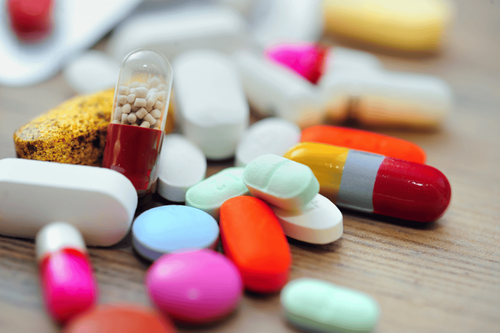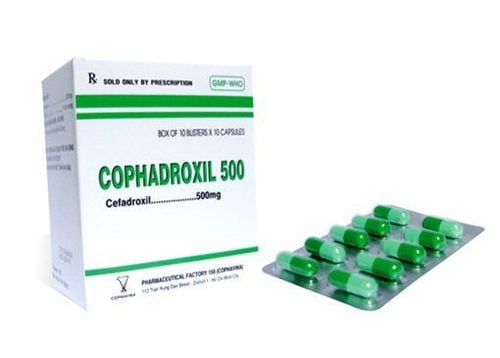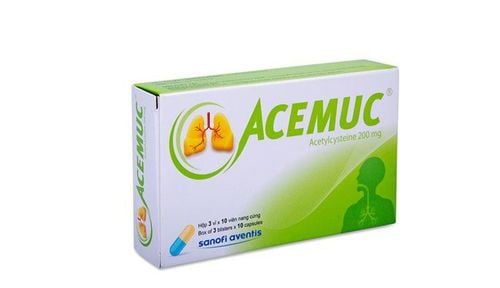This is an automatically translated article.
Oraldroxine 500 has the active ingredient Cefadroxil 500mg. This is a drug resistant to 1st generation Cephalosporin antibiotics, usually indicated in the treatment of mild and moderate infections caused by bacterial agents that are still sensitive to this antibiotic.1. What is Oraldroxine 500?
Oraldroxine 500 has the main ingredient Cefadroxil 500mg (as cefadroxil monohydrate) and is available in the form of hard capsules. Cefadroxil is a first-generation cephalosporin antibiotic that has bacteriostatic action by inhibiting bacterial growth and division through inhibition of bacterial wall synthesis. Cefadroxil is active against a wide range of bacteria including gram-positive and some gram-negative. Sensitive gram-positive organisms include Staphylococcus strains, both penicillinase-secreting and non-penicillinase-producing strains, beta-hemolytic Streptococcus strains, Streptococcus pneumoniae and Streptococcus pyogenes. Gram-negative bacteria that are susceptible to Cefadroxil antibiotics including Escherichia coli, Klebsiella pneumoniae, Moraxella catarrhalis, Proteus mirabilis and Haemophilus influenzae are often reduced susceptibility.Because now there have appeared many bacteria resistant to Cefadroxil, such as Methicillin-resistant Staphyloccus or Penicillin-resistant Streptoccus pneumoniae, all of which are resistant to Cephalosporin antibiotics.
2. Uses of Oraldroxine 500
Oraldroxine 500mg is effective against many types of bacteria, so it is indicated for use in mild and moderate infections caused by bacteria sensitive to this antibiotic, including:Urinary tract infections : Nephritis, acute and chronic pyelonephritis, cystitis, urethritis, bacterial vaginosis, gynecological infection. Respiratory tract infections such as: tonsillitis, pharyngitis, acute bronchitis and exacerbations of chronic bronchitis, lung abscess, pleurisy, rhinosinusitis, laryngitis, otitis media. Skin and soft tissue infections include: lymphadenitis, skin abscess, cellulitis, pressure sores, mastitis, boils, erysipelas. Other infections include: Osteoarthritis, septic arthritis. Oraldroxine 500 is contraindicated in the following cases:
Patients with a history of allergy to Cefadroxine or to any of the ingredients in Oraldroxine 500. History of allergy to Cephalosporin antibiotics should not used for cross-allergic reactions.
3. Dosage and how to use Oraldroxine 500
How to use: The drug is made in the form of hard capsules, should be taken orally. It should be taken with food to help reduce gastrointestinal side effects.Dosage for adults and children (over 40 kg):
Take 1 to 2 Oraldroxine 500 tablets each time and use 2 times a day depending on the degree of infection. For children (< 40 kg):
From 0 to 6 years old: Take with a dose of 250mg, 2 times a day. But should use powder package with appropriate amount and usage. Over 6 years old: Take 1 tablet/time, 2 times daily. Elderly: Renal function should be checked before use and then dose adjusted as in patients with renal impairment.
People with kidney failure : You can start taking 1 to 2 tablets. The next dose may be adjusted according to the creatinine clearance (ClCr) as follows:
Creatinine clearance less than 10 ml/min: Dose 1 to 2 tablets every 36 hours. Creatinine clearance: From 11-25 ml/min orally 1 to 2 tablets every 24 hours. Creatinine clearance from 26 to 50 ml/min: Dosage is 1 to 2 tablets every 12 hours. The duration of treatment with Oraldroxine 500 should be maintained for a minimum of 5 to 10 days, to avoid the risk of reinfection.
Overdose and missed dose:
Overdose: Acute overdose symptoms when taking drugs with high doses mostly cause only symptoms such as nausea, vomiting and diarrhea; In addition, patients may experience neuromuscular reactions, causing convulsions, especially overdosage is more common in patients with renal failure. When an overdose is recognized, the patient should be taken to a medical facility. The important initial treatment is to protect the patient's airway, ventilation and perfusion, and gastric lavage. After that, mainly supportive measures or symptom resolution. Missed dose: If you forget to take a dose of Cephadroxine, take it as soon as you remember. However, if it is almost time for your next dose, skip the missed dose and take your next dose at the scheduled time. Try not to miss a dose, as it affects the effectiveness of the antibiotic.
4. Side effects of Oraldroxine 500
When using Oraldroxine 500, you may experience unwanted effects, including:Common: Nausea, vomiting, abdominal pain and may cause diarrhea. Uncommon: Pruritus, maculopapular rash, rash, urticaria; eosinophilia; reversible increase in transaminases; testicular pain, vaginitis, fungal growth causing candidiasis, genital itching. Rare: Anaphylactic reactions, fever; neutropenia, thrombocytopenia, hemolytic anemia; pseudomembranous colitis, digestive disorders; skin allergies such as erythema multiforme, Stevens-Johnson syndrome, common pemphigus, toxic epidermal necrolysis (Lyell's syndrome); jaundice, cholestasis, hepatitis; angioedema ; nephrotoxicity can cause temporary increases in blood urea and creatinine, reversible interstitial nephritis; headache, agitation, convulsions and possibly joint pain. You may also experience other side effects while taking the medicine. If you experience side effects of Oaldroxime 500, you should stop using it and notify your doctor or go to the nearest medical facility for timely treatment.
5. Notes of Oraldroxine 500
It is important to inform your doctor before taking this medicine about a history of allergy to any agent, especially patients with a history of allergy to penicillins or other antibiotics because cross-hypersensitivity reactions have been observed. . Use the medicine exactly as prescribed by the doctor, do not arbitrarily change the dose or time of taking the medicine. When used for people with impaired kidney function, the elderly, infants, premature babies, liver failure, hepatitis, stomach ulcers ... need to be very careful. Cefadroxil, like other antibiotics, can cause overgrowth of non-susceptible bacteria when taken for a long time. Since then, can cause pseudomembranous colitis, should monitor signs such as prolonged diarrhea for early detection and caution in patients with a history of gastrointestinal disease, especially colitis. Use in pregnancy: Although no adverse effects have been reported to the fetus during maternal use, the safe use of cephalosporin antibiotics during pregnancy has not been reported. is determined. This drug should be used during pregnancy only if clearly needed. Lactation: Cefadroxil is excreted in breast milk in low concentrations, with almost no effect on the nursing infant, but may in Some cases still cause digestive disorders, should be concerned when children have diarrhea and rash.6. Drug interactions
Cholestyramine can bind with Cefadroxil in the intestine, thereby slowing down the absorption and reducing the antibacterial effect of the drug. Probenecid when used concurrently reduces Cephalosporin excretion, the risk of drug accumulation. Increased toxicity of Cefadroxine: Furosemide and Aminoglycoside may synergistically increase nephrotoxicity. In addition, there may be interactions with other drugs, so care should be taken when taking them together. Storage: Keep the medicine in a dry place, the storage temperature should not exceed 30°C, avoid direct light. Keep medicine out of reach of children. Oraldroxine 500 is an antibiotic that should only be used for bacterial infections and under the direction of a doctor. You should not self-administer when you have a viral infection or there is not enough evidence of infection because of the increased risk of drug resistance and development of non-susceptible organisms.Please dial HOTLINE for more information or register for an appointment HERE. Download MyVinmec app to make appointments faster and to manage your bookings easily.













